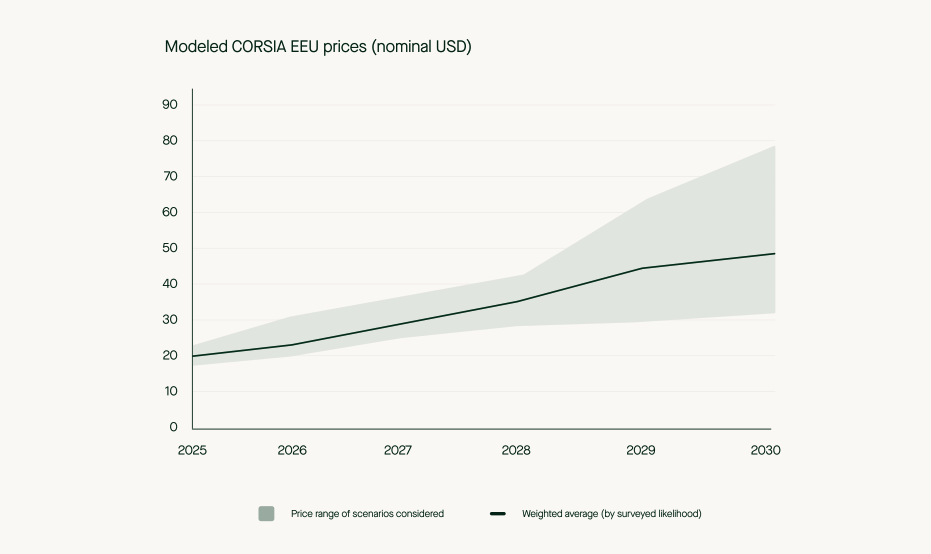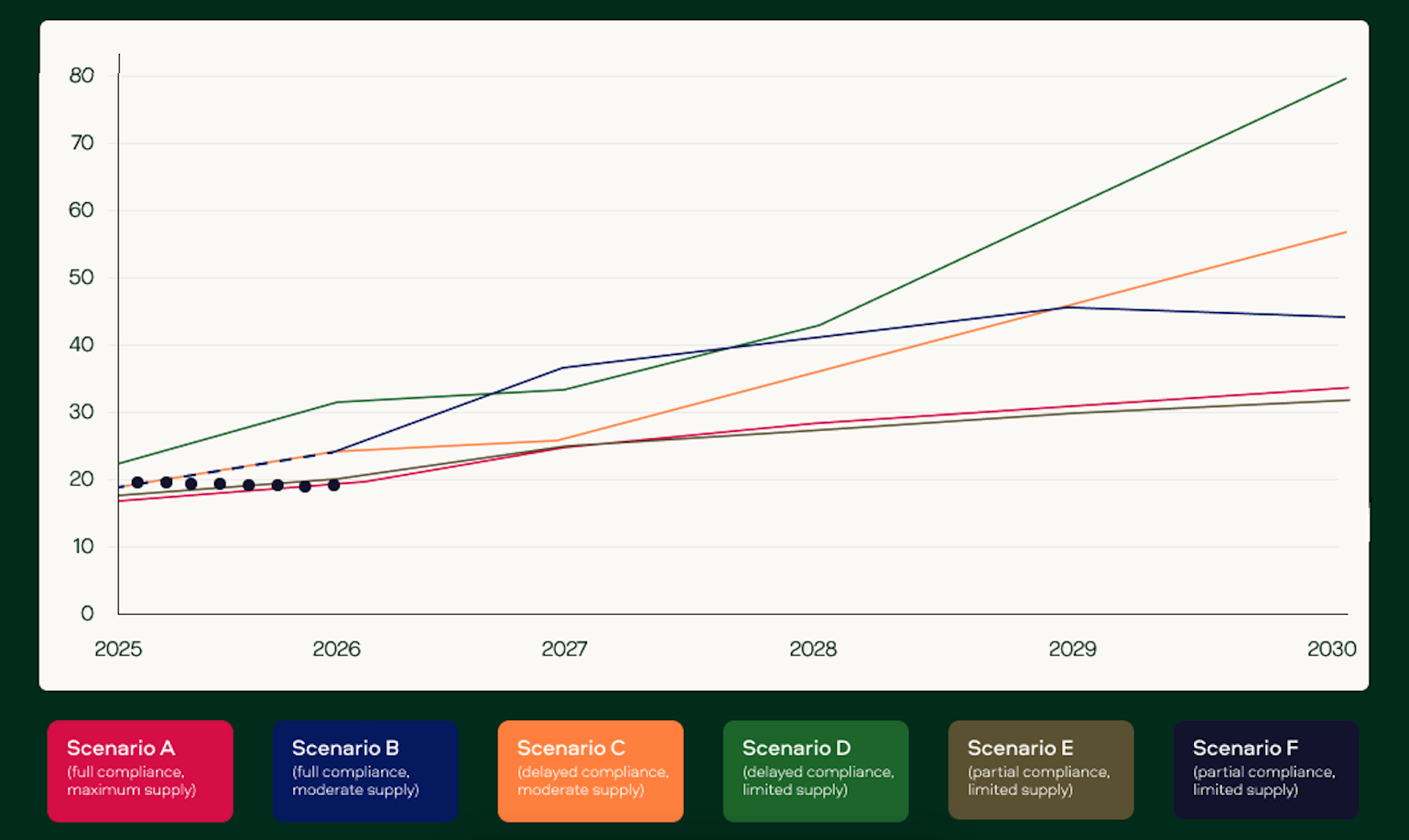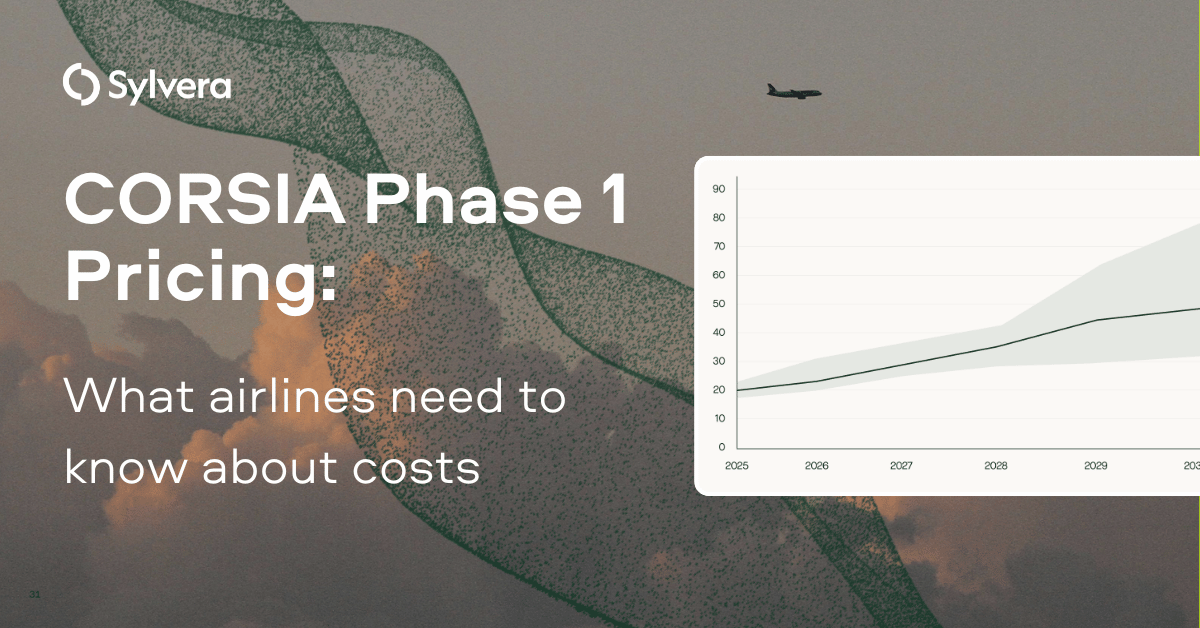“Over the years we’ve invested significantly in our field data team - focusing on producing trusted ratings. While this ensures the accuracy of our Ratings, it doesn’t allow the scale across the thousands of projects that buyers are considering.”
For more information on carbon credit procurement trends, read our "Key Takeaways for 2025" article. We share five, data-backed tips to improve your procurement strategy.

One more thing: Connect to Supply customers also get access to the rest of Sylvera's tools. That means you can easily see project ratings and evaluate an individual project's strengths, procure quality carbon credits, and even monitor project activity (particularly if you’ve invested at the pre-issuance stage.)
Book a free demo of Sylvera to see our platform's procurement and reporting features in action.
What will CORSIA carbon credits actually cost airlines?
As the aviation industry approaches CORSIA's First Phase compliance deadline of January 31, 2028, one question dominates boardroom discussions: What will CORSIA carbon credits actually cost airlines?
The Carbon Offsetting and Reduction Scheme for International Aviation (CORSIA) represents the world's first global market-based climate program for aviation. Under CORSIA, airlines must purchase Eligible Emissions Units (EEUs) to offset any emissions exceeding 85% of their 2019 baseline. With international aviation emissions rebounding post-COVID, airlines are now facing the reality of substantial offsetting requirements.
However, CORSIA carbon credit pricing remains one of the most volatile variables in aviation cost planning. Unlike established carbon markets, CORSIA operates in a nascent market with limited liquidity, uncertain supply chains, and complex regulatory requirements that make price forecasting particularly challenging.
What the latest data reveals about CORSIA costs
Projected price ranges: $25-36 per ton by 2027
Our recent market modeling suggests CORSIA carbon credit prices will likely reach $25-36 per EEU by 2027, depending on two critical factors: supply availability and airline compliance levels. This represents a significant increase from current limited market activity, where Guyana's JREDD+ credits were offered at $21.70 in late 2024.
The wide price range reflects fundamental market uncertainties:
Supply-side constraints: Currently, only one major supply source has issued CORSIA-eligible credits (15.84 million from Guyana's jurisdictional REDD+ program). The broader supply depends on host country authorizations under Article 6 of the Paris Agreement — a process that remains largely slow globally.
Demand variability: First Phase demand could range from 74 to 144 million EEUs, depending on whether airlines comply voluntarily or through regulatory enforcement. Airlines in the EU, US, UAE, and UK alone could represent half of Phase 1 offsetting requirements.

Market value: A multi-billion dollar impact
The total primary market value for CORSIA First Phase EEUs is estimated between $1.8 billion and $5.2 billion - comparable to the entire voluntary carbon market on an annualized basis. This scale represents a fundamental shift in aviation cost structures.
For context, if demand reaches 144 million EEUs at $36 per ton, the total market value would exceed $5 billion. Even under partial compliance scenarios (74 million EEUs at $25 per ton), airlines would face collective costs of approximately $1.8 billion.
Difference CORSIA scenarios, different cost realities
As part of Sylvera’s industry-first CORSIA scenario modeling, we proposed distinct scenarios for CORSIA implementation, each with dramatically different pricing implications, ranging across:
Best Case (Full Compliance, Maximum Supply): With broad host country participation and significant JREDD+ and PACM credit issuances, prices remain relatively moderate around $25 by 2027.
Moderate Supply Scenarios: Limited host country authorizations could push prices to $36 by 2027, with further increases as the compliance deadline approaches.
Supply Crunch Scenarios: If only 7 countries provide authorizations between 2025-2026, prices could exceed $60 for Phase 1 compliance as airlines compete for scarce credits.
Delayed Compliance: Should ICAO delay the compliance deadline to January 2030 due to supply shortages, prices would initially moderate but surge again as the new deadline approaches.

What can airlines do to plan for CORSIA right now?
1. Understand the multiple cost scenarios
Airlines should model costs across the $25-60 per EEU range, factoring in their specific offsetting requirements. For a major carrier with 10 million tons of excess emissions, the difference between best and worst-case scenarios could mean $250 million versus $600 million in compliance costs.
2. Begin procurement relationships now
With limited supply sources and uncertain authorization processes, airlines should establish relationships with credit suppliers and aggregators, if they don’t already exist. Early engagement provides better visibility into supply availability and potential volume savings.
3. Monitor host country authorization progress
Airlines should track which countries are developing Article 6 authorization frameworks, as this directly impacts credit availability from projects in those jurisdictions. Currently, only about 16 countries are considered moderately ready for authorizations.
The compliance deadline is approaching fast
With January 2028 on the horizon, airlines cannot afford to delay CORSIA planning. The combination of regulatory uncertainty, supply constraints, and competitive demand creates a perfect storm for price volatility.
Airlines that begin procurement planning now position themselves to secure compliance at reasonable costs. Those who wait risk facing supply shortages and premium pricing as the deadline approaches.
Get the full CORSIA market analysis
The comprehensive research available in Sylvera's CORSIA First Phase Scenario Modeling report helps airlines and market players better understand the potential scenarios. The full analysis includes detailed price and supply projections, host country readiness assessments, and regulatory scenario planning across 40+ expert consultations.
Download the full report to access complete market modeling, detailed scenario analysis, and strategic recommendations for navigating CORSIA compliance.

Helping airlines navigate CORSIA complexity
With deep expertise in both carbon markets and policy, Sylvera provides the critical intelligence and tools needed to succeed in the evolving CORSIA landscape.
Strategic CORSIA compliance & market intelligence
Our policy experts help airlines, investors, and carbon market participants develop robust CORSIA compliance strategies by providing realistic assessments of market scenarios and regulatory developments. We help you navigate uncertainty and position for action before prices rise, ensuring your strategies remain resilient across multiple scenarios.
End-to-end support
From initial discovery through rigorous due diligence to ongoing monitoring, Sylvera supports your complete journey with CORSIA-eligible credits. Our trusted ratings provide deep project-level analysis to assess true quality and risk. With limited supply and intensifying demand for CORSIA-eligible credits, we help you identify high-quality opportunities in this nascent market.
Data-driven decision making
Having reliable data and insights is crucial for informed decision-making. Sylvera's Market Data provides real-time market intelligence, and our in-house scenario modeling helps you take low-risk climate action.
If you need expert guidance in navigating CORSIA, our team is ready to help. Get a free Sylvera demo here.















